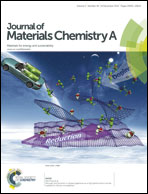The formation mechanism of layered double hydroxide nanoscrolls by facile trinal-phase hydrothermal treatment and their adsorption properties†
Abstract
The formation mechanism of layered double hydroxide (LDH) nanoscrolls via a trinal-phase hydrothermal system has been investigated via powder X-ray diffraction and transmission electron microscopy (TEM) at different reaction temperatures and times. LDH nanosheets formed at first and subsequently developed into nanoscrolls. Notably, the investigation confirmed that urea and pressure played key roles in the formation of the one-dimensional LDH structure. Further observations by scanning electron microscopy and high-resolution TEM indicated that the nanoscrolls with apparent hollow cores were derived from nanosheets through a roll-up process, rather than through the control of the crystal growth in one particular direction. A detailed model was also proposed to describe the reaction process based on the assumption that the LDH growth units are anion coordination octahedra. Furthermore, owing to the increased specific surface area and novel structure, the nanoscrolls exhibit high adsorption capacity and excellent reusability in the adsorption of methyl orange in aqueous solution.


 Please wait while we load your content...
Please wait while we load your content...